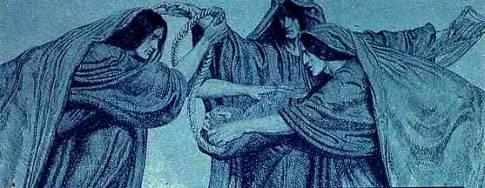Perhaps one of the most ancient and widely distributed traditions in the western Indo European lore is that of the Three Sisters of Destiny; known to the Northern tribes as the Norns. Each of the sisters represent a different aspect of time: the first, an old hag, peers off into the left or west… Urdr, the past. The second, a woman of middle-years, stares straight ahead to the south… Verdandi, the present. And the third, a youth, looks off to the right or east… Skuld, the future.

The Greeks knew them as the Morari: Clotho, Lachesis and Atropos. To the Romans they were the Parcae: Nona, Decima, and Morda. The hag spools the thread from her spindle to the middle woman who measures it, passing it on to the youth who, faceless, cuts it with her shears.
Each sister sees and knows and to a large degree governs her own temporal realm of destiny. These ancient and powerful spirits are perhaps best approached after All Hallows, in the Dead of the Year; between the worlds, in the Wasteland: the desolate wandering place much like the blasted heath upon which Macbeth encountered the same three Weird Sisters later immortalized by Shakespeare. The story of Macbeth and Banquo’s encounter with three weird sisters who address Macbeth in terms of his past, present and future, had already long been a part of the folk record by the time Shakespeare incorporated it into his play. In the lore of the Northern Tradition preserved in the Icelandic Eddas, the Norns were to be found at the base of Ygddraisil, the World Ash-tree. In the shadowy realm between this world and the underworld, at the roots of the Tree, they dwell in a cave that embraces a pool fed by the twelve fountains (or nine rivers) which ever feed and replenish that representative of the Great Well or Cauldron of all origins. It is there they continually tend the roots with water and clay and there they spin and weave their Great Webs; the great fabric of existence: the Wyrd.
To the Dark-Ages people of ancient Northern Europe (including most of the British Isles,) the Wyrd was a very familiar and important dimension of their view of the world; a philosophy not unlike the Eastern Tradition’s Tao. Whereas the oriental view has the world and our lives made up of the dynamic interplay of a set of opposites, Yin and Yang, in the west a similar dynamic was seen in the meshing of the Weavers’ threads. Consider the powerful old European metaphor of the Wyrd: the stuff of existence being like a woven fabric: an infinite number of fibers meshed at right angles to as many more opposing fibers; each single thread at some point touches and affects every single other opposing thread… a truly profound image for our contemplation…
Page Information:
“The Norns: Three Sisters in the Wasteland.” submitted by Earrach